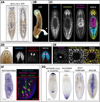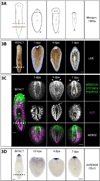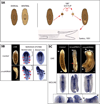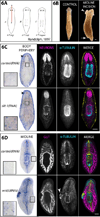The history and enduring contributions of planarians to the study of animal regeneration
- PMID: 23799578
- PMCID: PMC3694279
- DOI: 10.1002/wdev.82
The history and enduring contributions of planarians to the study of animal regeneration
Abstract
Having an almost unlimited capacity to regenerate tissues lost to age and injury, planarians have long fascinated naturalists. In the Western hemisphere alone, their documented history spans more than 200 years. Planarians were described in the early 19th century as being 'immortal under the edge of the knife', and initial investigation of these remarkable animals was significantly influenced by studies of regeneration in other organisms and from the flourishing field of experimental embryology in the late 19th and early 20th centuries. This review strives to place the study of planarian regeneration into a broader historical context by focusing on the significance and evolution of knowledge in this field. It also synthesizes our current molecular understanding of the mechanisms of planarian regeneration uncovered since this animal's relatively recent entrance into the molecular-genetic age.
Copyright © 2012 Wiley Periodicals, Inc.
Figures

“‘Doko’ or ‘Toku’. The animal has the shape of a Japanese belt in general appearance and is without legs. It measures up to 12 to 15 cm in length; a large specimen attains about 30 cm. The body is flattish in shape as a leaf of leek. There are yellow and black folds on the dorsal surface. The animal has a head shaped like a Japanese forceps…If the animal is touched, fission may occur…”






References
-
- Dinsmore CE. Urodele limb and tail regeneration in early biological thought: an essay on scientific controversy and social change. Int. J. Dev. Biol. 1996;40:621–627. - PubMed
-
- Aristotle, Balme DM, Gotthelf A, Peck AL. Historia animalium. London; Cambridge, Mass: Heinemann; Harvard University Press; 1965.
-
- Anonymous. Histoire de l'Académie Royale des Sciences depuis 1686 jusqu'à son renouvellement en 1699. Vol. 2. Paris: Bibliothèque De M. J.-A. Barral; 1773.
-
- de Réaumur M. Sur les diverses reproductions qui se font dans les Ecrevisse, les Omars, les Crabes, etc. et entr'autres sur celles de leurs Jambes et de leurs Ecailles. Memoirs of the Royal Academie of Sciences. 1712:223–242.
-
- Lenhoff SG, Lenhoff HM, Trembley A. Hydra and the Birth of Experimental Biology, 1744: Abraham Trembley's Mémoires Concerning the Polyps. Pacific Grove, CA: Boxwood Press; 1986.
Publication types
MeSH terms
Grants and funding
LinkOut - more resources
Full Text Sources

